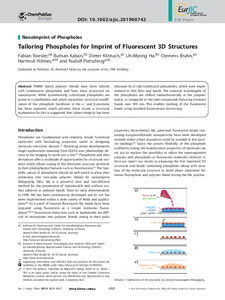Tailoring Phospholes for Imprint of Fluorescent 3D Structures
| dc.date.accessioned | 2020-01-17T08:27:57Z | |
| dc.date.available | 2020-01-17T08:27:57Z | |
| dc.date.issued | 2019-11-06 | |
| dc.identifier | doi:10.17170/kobra-20200117935 | |
| dc.identifier.uri | http://hdl.handle.net/123456789/11426 | |
| dc.description.sponsorship | Gefördert im Rahmen des Projekts DEAL | |
| dc.language.iso | eng | |
| dc.rights | Urheberrechtlich geschützt | |
| dc.rights.uri | https://rightsstatements.org/page/InC/1.0/ | |
| dc.subject | phospholes | eng |
| dc.subject | reverse nanoimprint lithography | eng |
| dc.subject | fluorescence | eng |
| dc.subject | silicon | eng |
| dc.subject | solid-state structures | eng |
| dc.subject.ddc | 540 | |
| dc.title | Tailoring Phospholes for Imprint of Fluorescent 3D Structures | eng |
| dc.type | Aufsatz | |
| dcterms.abstract | PMMA based polymer blends have been infused with luminescent phospholes and have been structured via nanoimprint. While symmetrically substituted phospholes are prone to crystallization and phase separation, structural modification of the phosphole backbone in the α‐ and β‐positions has been explored, which prevents these issues; a structural explanation for this is suggested. Best phase integrity has been obtained for β‐silyl‐substituted phospholes, which were implemented in thin films and beads. The emission wavelengths of the phospholes are shifted bathochromically in the polymer matrix as compared to the neat compounds featuring emission bands near 500 nm. This enables tracking of the fluorescent beads using standard fluorescence microscopy. | eng |
| dcterms.accessRights | open access | |
| dcterms.creator | Roesler, Fabian | |
| dcterms.creator | Kaban, Burhan | |
| dcterms.creator | Klintuch, Dieter | |
| dcterms.creator | Ha, Uh-Myong | |
| dcterms.creator | Bruhn, Clemens | |
| dcterms.creator | Hillmer, Hartmut | |
| dcterms.creator | Pietschnig, Rudolf | |
| dc.relation.doi | doi:10.1002/ejic.201900742 | |
| dc.type.version | publishedVersion | |
| dcterms.source.identifier | ISSN 1099-0682 | |
| dcterms.source.issue | Issue 45 | |
| dcterms.source.journal | European journal of inorganic chemistry (EurJIC) | eng |
| dcterms.source.pageinfo | 4820-4825 | |
| dcterms.source.volume | Volume 2019 |
Dateien zu dieser Ressource
Das Dokument erscheint in:
-
Artikel [1106]

